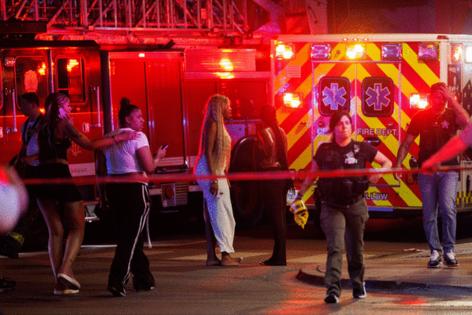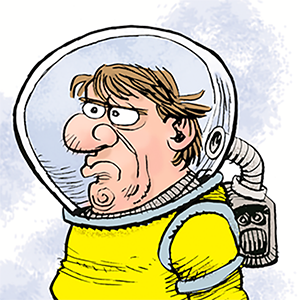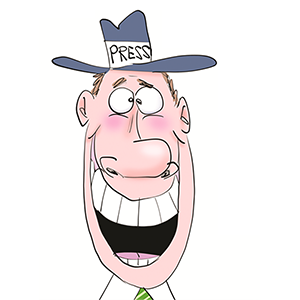Stubborn feud between gangs surfaces again in Chicago's River North mass shooting
Published in News & Features
CHICAGO — It was a jarring act of violence that again put Chicago in an unwanted spotlight and left River North on edge.
A drive-by shooting into a crowd of people waiting outside a lounge on Chicago Avenue left four dead and 14 others injured, making it one of the worst such attacks in the city’s recent memory.
Chicago police and City Hall officials were quick to note that the shooting was targeted and the victims didn’t live in the neighborhood. And just hours after the gunfire, Chicago Police Department Superintendent Larry Snelling told reporters the shooting was not a random incident.
“Obviously, there’s a motive there,” Snelling said.
No arrests have been made in the shooting, according to CPD.
The party that was attacked was organized to celebrate an album release by Chicago drill rapper Mello Buckzz, a rising artist who on social media claims an affiliation with “NLMB,” a gang faction based in the South Shore and Greater Grand Crossing neighborhoods that, sources say, is linked to a host of deadly shootings in recent years.
NLMB has feuded openly with opposing South Side gangs, sources have said, where each has used their music and social media to taunt each other before sometimes exchanging hits on opposition members.
Among the most high-profile NLMB associates is Chicago drill rapper G Herbo, who collaborated with Mello Buckzz in a song released in 2024.
On her social media channels, the rapper — born Melanie Doyle — has said that her significant other and best friend were among those killed.
Representatives for Doyle did not respond to requests for comment for this story.
Police also have provided no official updates in recent days. Snelling has said investigators were pulling video surveillance footage from the area, asking the public for tips on who is to blame, and working to head off any retaliation.
A history of violence
One member of NLMB was charged in another quadruple murder in South Shore in 2017 — a shooting that occurred on a day that saw seven killings in the neighborhood.
Those charges were dropped in 2020 after an informant told investigators that the wrong person was accused in the killings.
In February 2021, another NLMB associate — a close friend of Chicago rapper G Herbo — was killed in a brazen daytime shooting inside a South Loop barbershop.
Less than two months later, another mass shooting unfolded at a rented-out storefront business on West 79th Street in the Ashburn neighborhood. That night, members of the Pocket Town faction of Gangster Disciples — a rival of NLMB also based in Greater Grand Crossing — had gathered to celebrate the birthday of a Pocket Town member shot to death six months earlier.
That shooting on 79th Street left one man dead, a member of Pocket Town, and seven others injured. Police sources noted an “emerging conflict” at the time between Pocket Town and NLMB — an acronym for “No Limit Muskegon Boyz” and “Never Leave My Brothers.”
More than 100 shell casings were recovered at the scene. No charges were ever filed in that mass shooting, but the evidence recovered at the scene ultimately led to federal charges.
The next year, another NLMB rival, rapper KTS Dre, was killed in a hail of gunfire outside the Cook County Jail just minutes after he was released from the custody of the Cook County sheriff’s office.
While groups like NLMB have some ties to older, well-known gangs like the Black P Stones, they operate in a much more splintered landscape than existed in the late 1990s and early 2000s.
Less leadership
Andrew Papachristos, a Northwestern University sociologist who studies how violence reverberates through social networks, attributed that changed landscape to a federal crackdown on the highly organized “supergangs” that targeted leaders like Larry Hoover of the Gangster Disciples, as well as the demolition of larger public housing facilities and school closures, which were “ways to control recruitment flows of organizations.”
The result is that while the names of old leaders and their organizations are still well known, “the structures are like ghosts, and they matter more for the 40 year olds than to the 20 year olds,” he said.
In some ways, Papachristos said, today’s gangs are more similar to the groups that existed in the 1960s. But increased availability of guns and the increased capacity of those weapons following the Vietnam War meant that the stakes of “arms races” between groups became more deadly.
“If you can spray 40 rounds per incident instead of six, there are going to be more fatalities,” he said. “It was always who had a bigger arsenal and bigger force, whether you had baseball bats and chains (or) someone had a gun.”
And there is the availability of smartphones and the proliferation of social media, which Papachristos described as an accelerant — “it amplifies things really fast, all the time.”
Deeper issues
But despite the well-publicized associations between drill music and shootings like the one that rocked the city last week, experts who study city violence warned against blaming shootings on the music itself, which proliferates in many of the neighborhoods that bear the brunt of Chicago’s problem with gun violence.
Much of the violence that occurs today has roots that are decades old, they said, and tangled in intergenerational conflicts that predate drill, social media and many of the groups thought to be behind some of the highest-profile attacks.
“We lose the fact that there is a simmering life or death battle happening, that the tweet or the Instagram post or the drill song is like the ordainment of that,” said Stanford University sociologist Forrest Stuart. “It’s an expression of a much deeper set of relationships.”
While people commonly attribute violence to barbs thrown on social media, Stuart, who wrote the 2020 book “Ballad of the Bullet: Gangs, Drill Music, and the Power of Online Infamy,” said it more often works the other way around.
“They say the violent taunt has a causal arrow that then causes violence offline, but all the cutting edge research that we have now shows that that it’s the violent attack offline (that then is) showing up online,” he said.
Most of the social media posts that result in violence are not videos of people showing off guns or making threats, he said. They’re more mundane.
They show someone at a bus stop or outside a school, “in an area that’s accessible, that’s open, (where) someone calculates that they can get away with a shooting without being apprehended.”
If no one intervenes‚ he said, someone who was already planning to target the person making the post knows exactly where to find them.
____
©2025 Chicago Tribune. Visit at chicagotribune.com. Distributed by Tribune Content Agency, LLC.







Comments